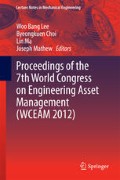Abstract
Gartner suggested that 80 % of organizational data is unstructured and has not been made available to the users. As a result, most organizations have far more data than they possibly use, yet at the same time, they do not have the quality data they really need. With the participation of an Australian Power Utility Company, this research demonstrated the value of unstructured data found in the plant incident reports (which are Word documents stored in the public directory of the exchange server) by conducting text analysis with special in-house-developed software.
Access this chapter
Tax calculation will be finalised at checkout
Purchases are for personal use only
References
Ballou DP, Pazer HL (1995) Designing information systems to optimize the accuracy-timeliness tradeoff. Inf Syst Res 6(1):51–72
Eerens E (2003) Business driven asset management for industrial & infrastructure assets Australia. Le Clochard
English LP (1999) Improving data warehouse and business information quality: methods for reducing costs and increasing profits. Willey, NY
Gao J, Koronios A, Lin S (2006) Data quality in engineering asset management organisations—Current picture in Australia. In: The international conference of information quality, Boston
IPWEA (2002) International infrastructure management manual Australia/New Zealand Edition
Klein BD, Goodhue DL, Davis GB (1997) Can humans detect errors in data? Impact Base Rates Incentives Goals MIS Q 21(2):169–194
Kriebel CH (1979) Evaluating the quality of information systems. In: Szysperski N, Grochla E (eds) Design and implementation of computer based information systems, Sijthroff and Noordhoff, Germantown
Levitan AV, Redman TC (1998) Data as a resource: properties implications and prescriptions. Sloan Manag Rev 40(1):89–101
Orr K (1998) Data quality and system theory. Commun ACM 41(2):66–71
Shanks G, Darke P (1998) Understanding data quality in a data warehouse. Aust Comput J 30(4):122–128
Snitkin S (2003) Collaborative asset lifecycle management vision and strategies. Research Report ARC Advisory Group, Dedham
Sokianos N, Druke H, Toutatoui C (1998) Lexikon productions management. Landsberg
Spires C (1996) Asset and maintenance management—becoming a boardroom issue. Managing Serv Q 6(3):13–15
Steed JC (1988) Aspects of how asset management can be influenced by modern condition monitoring and information management systems. IEEE
Steenstrup K (2005) Enterprise asset management thrives on data consistency. Gartner Research Article
Strong DM (1997) IT process designs for Improving Information Quality and reducing exception handling: a simulation experiment. Inf Manag 31:251–263
Strong DM, Lee YW, Wang RY (1997) Data quality in context. Commun ACM 40:103–110
Wang RY, Kon HB (1993) Toward total data quality management (TDQM). In: Wang RY (eds) Information technology in action: trends and perspectives. Prentice Hall, Englewood Cliffs
Wang RY, Strong DM (1996) Beyond accuracy: what data quality means to data consumers. J Manage Inf Syst 12(4):5–33
Acknowledgments
This paper was developed within the CRC for Infrastructure and Engineering Asset Management, established and supported under the Australian Government’s Cooperative Research Centres Programme. The authors gratefully acknowledge the financial support provided by the CRC.
Author information
Authors and Affiliations
Corresponding author
Editor information
Editors and Affiliations
Rights and permissions
Copyright information
© 2015 Springer International Publishing Switzerland
About this paper
Cite this paper
Gao, J., Koronios, A. (2015). Unlock the Value of Unstructured Data in EAM. In: Lee, W., Choi, B., Ma, L., Mathew, J. (eds) Proceedings of the 7th World Congress on Engineering Asset Management (WCEAM 2012). Lecture Notes in Mechanical Engineering. Springer, Cham. https://doi.org/10.1007/978-3-319-06966-1_25
Download citation
DOI: https://doi.org/10.1007/978-3-319-06966-1_25
Published:
Publisher Name: Springer, Cham
Print ISBN: 978-3-319-02461-5
Online ISBN: 978-3-319-06966-1
eBook Packages: EngineeringEngineering (R0)

